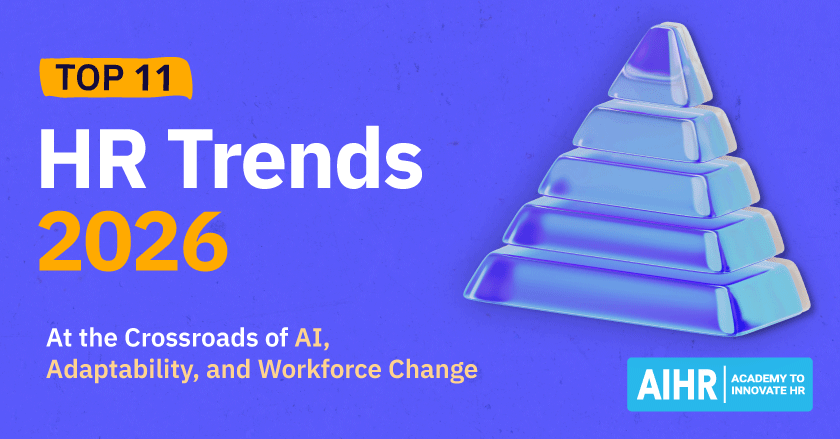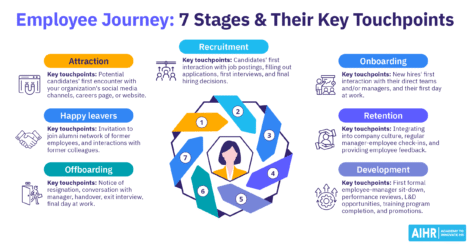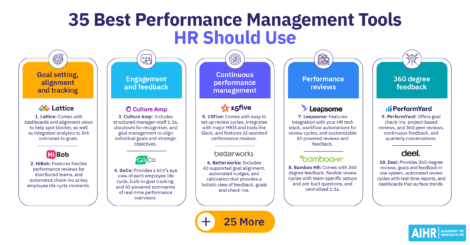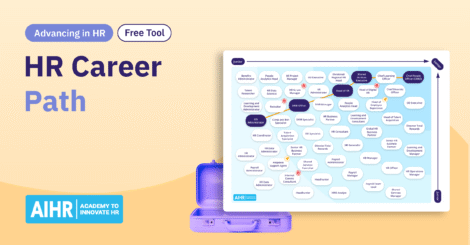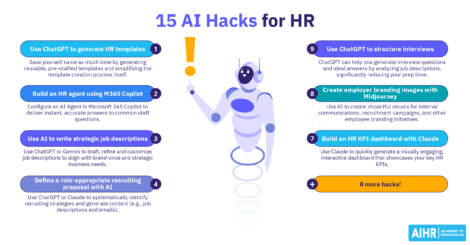Job task analysis (JTA) can mean the difference between understanding the key requirements for a job and having a full view of the day-to-day tasks it involves. Without this level of detail, it becomes difficult not only to hire the right people but also to train and develop them once they’re in the role. The tasks identified in a JTA also highlight the specific skills and competencies needed to carry them out, giving both employers and candidates a clearer picture of what success looks like.
This becomes especially important when you look at how job descriptions are often perceived. A poll found that while 72% of hiring managers believe their job descriptions are clear, only 36% of candidates agree. In fact, 67% of candidates said unclear descriptions were a “communication barrier.” When the expectations of a role aren’t clearly defined, it frustrates applicants and employees alike, limits the pool of qualified candidates, and leaves new hires without a solid foundation for success.
The result? Fewer strong candidates in the pipeline, challenges in onboarding and development, and organizations missing out on top talent. In this article, we’ll explore what a job task analysis is, the many ways it can benefit your organization, and how to conduct an effective job task analysis.
Contents
What is a job task analysis?
How to conduct an effective job task analysis in 9 steps
Job task analysis example
FAQ
What is a job task analysis?
Job task analysis (JTA) is a structured process for identifying, describing, and evaluating the tasks, duties, and skills required to perform a specific role effectively. It is a method of job analysis. Unlike a broader job analysis, which outlines overall responsibilities of a role, JTA focuses on the detailed tasks that define how the work actually gets done.
For example, a job analysis of a receptionist role would include a job summary, the work environment in which the job takes place, and the general requirements of the job, such as communication skills, customer service skills, and computer skills. However, a job task analysis would uncover much more detailed tasks such as updating customer information in a CRM or Excel sheet, creating, sending, and receiving invoices, managing multiple colleagues’ business calendars, and scheduling appointments.
A job task analysis has a wide range of applications across the employee life cycle:
- Recruitment and selection: JTA forms the basis for clear and accurate job descriptions that attract the right candidates.
- Training and development: Identifying the specific skills and knowledge needed for each role.
- Performance management: The analysis provides clear standards for evaluating and guiding employees.
- Compensation and career progression: Ensuring pay and promotion decisions are based on well-defined responsibilities and competencies.
- Compliance: Keeping job documentation aligned with legal, safety, and professional standards.
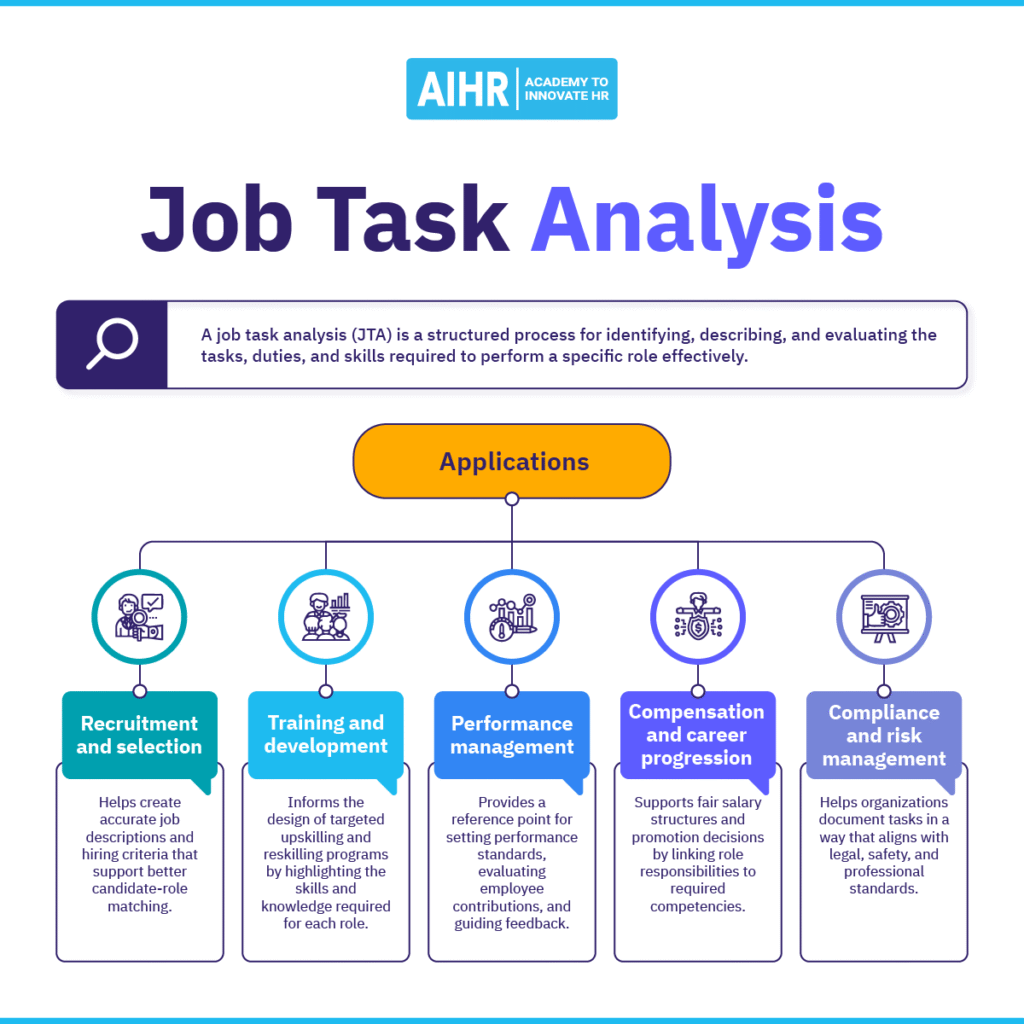
The benefits of conducting a job task analysis include:
- Understanding the skills, competencies, and behaviors your organization needs
- Creating clear and accurate job descriptions
- Hiring the right candidates for the right roles
- Easily explaining tasks to employees and the steps involved
- Identifying skills gaps
- Designing relevant training programs to upskill and reskill employees so they can perform effectively
- Making fair salary and promotion decisions
- Continuous improvement for the business
- Ensuring legal and professional compliance.
How to conduct an effective job task analysis in 9 steps
Let’s explore AIHR’s job task analysis process.
1. Define the purpose of the analysis
The first step is to get clear on your goal. What is your main purpose for conducting a job task analysis? What are your main objectives and the outcomes you’d like to achieve?
For example, you may want to improve recruitment, design more effective training programs, or strengthen compliance by clearly documenting job duties and qualifications to align hiring, training, and job classifications with legal and regulatory standards (or all of the above).
2. Use a job task analysis template
Beginning with a structured framework will ensure consistency and thoroughness across all roles in your organization. Use a job task analysis template when analyzing each role to stay on track.
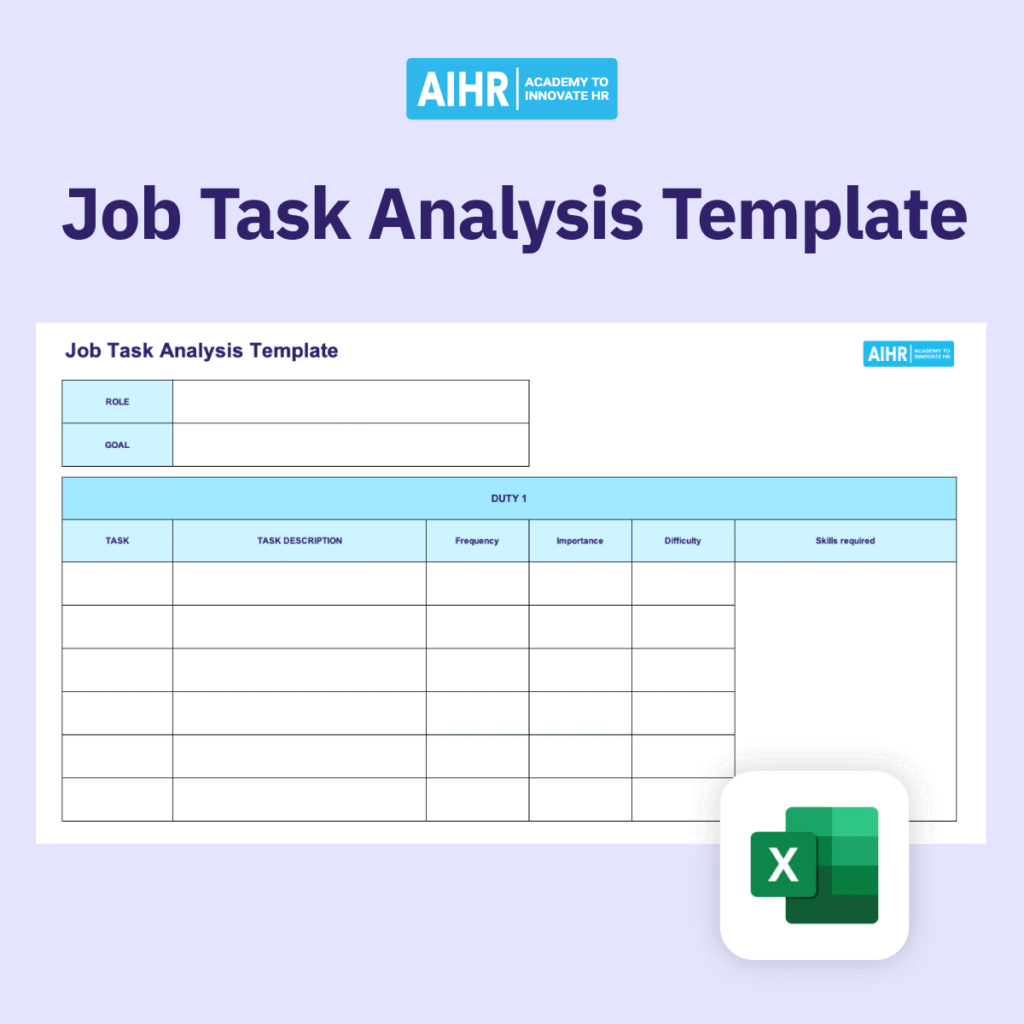
3. Identify essential tasks performed in a job role
The next step is to create a comprehensive list of tasks performed in each role, on a daily, weekly, and monthly basis. A task is one unit of work, has a clear beginning and end, and results in the completion of either a product or process. For example, a job responsibility may be to fulfill customer orders; however, this could be broken down into several tasks, including printing the order information for the label and packaging the orders ready to be shipped.
The best way to identify the job tasks is through a combination of:
- Observation: Watch employees complete tasks in their natural work environment.
- Interviews and focus groups: Sit down with employees and managers and ask about their jobs and tasks, such as what they do, how they do it, and the purpose of each task.
- Questionnaires: A customized questionnaire can help you collect a wide range of data from employees.
- Review documents: Look at documents related to jobs and tasks (manuals, SOPs, policies, and reports).
4. Create task descriptions
You can write clear, action-oriented statements from your data that define each task and how it is performed. Each description should specify what the employee does, how they do it, and why it matters to the role or business outcome. This helps ensure consistency and clarity across job roles and makes it easier to evaluate performance later on.
For example, if the task you’ve identified is “Handle customer complaints”, the description could be: “Resolve customer complaints by identifying the issue, researching solutions, and following up within 24 hours to confirm resolution and customer satisfaction.”
5. Evaluate task importance and frequency
For each role, prioritize task descriptions based on their importance to job success and how frequently they are carried out. Ranking tasks based on order of importance helps both employees and managers understand which tasks matter most and helps HR focus their learning and development efforts on the most essential aspects of each job.
Level up your talent management skills
A clear understanding of roles, skills, and performance expectations is essential to managing talent effectively. Whether you’re defining job tasks or designing development plans, strategic talent management starts with the right foundation.
With the Talent Management Certificate Program, you’ll learn to:
✅ Take a data-driven approach to talent management
✅ Develop effective talent management frameworks
✅ Design succession planning strategies that work
✅ Strengthen employee development, retention, and internal mobility
🎓 Strengthen your role as a talent partner with skills that drive real results.
6. Assess required competencies and skills
The next step is conducting a competency assessment for your identified tasks. This is where you list the technical skills, knowledge, and behavioral competencies needed for effective performance in the role based on the required tasks.
The Future of Jobs report by the World Economic Forum shows that 50% of workers have undergone some form of training, reskilling, or upskilling in the past two years, which demonstrates the growing need for training employees. When managers and HR understand the competencies and skills required to perform in a role, and compare these with employees’ existing skills, they can spot the gaps and bridge them with targeted training programs.
7. Incorporate input from subject matter experts
It can be helpful to validate your findings by consulting with other experts who are familiar with the roles you’re analyzing. Seek subject matter experts who have a documented history of working in the area of expertise in question, have conducted similar work and therefore understand its challenges, and are aware of industry best practices.
8. Document findings for future reference
It’s essential to compile all your job task analysis results into a job profile or database. This includes how you collected data and the sources you used, who you observed and interviewed, how people were assessed, the tools used to analyze data, and the conclusions you came to based on the data.
This will be helpful when conducting a future job task analysis, and can also be used for training, evaluation, and workforce planning efforts.
9. Maintain and update job task analysis regularly
All jobs evolve over time, particularly as the needs of a business change and technology advances are leveraged more in the workplace. It’s important to review and refresh your job task analysis to reflect these changes and ensure your understanding of all roles and tasks remains up to date.
Job task analysis example
Here’s an example of a job task analysis for a Customer Service Assistant role.
Title: Customer Service Assistant
Goal: To provide excellent customer support to all customers, resolve any issues, and maintain high levels of customer satisfaction and sales.
Duty: Customer support and communication
| Task | Task description | Frequency | Importance | Difficulty |
| Responding to customer inquiries via phone, email, or chat | Provide accurate and timely information to customers about products, services, and policies. | 50/day | High | Medium |
| Logging customer interactions in the CRM system | Record customer details, issues, and resolutions accurately to maintain up-to-date service records. | 50/day | High | Medium |
| Resolving customer complaints | Listen to customer concerns, identify the root cause, and offer solutions or escalate when necessary. | 10/day | High | High |
| Processing orders, returns, and refunds | Handle order requests, cancellations, and refund processes according to company procedures. | 20/day | Medium | Medium |
| Following up on unresolved customer issues | Track pending cases and reach out to customers to confirm resolution and satisfaction. | 10/day | High | Medium |
Skills and competencies required
- Strong communication (primarily written)
- Active listening skills
- Problem-solving skills
- Conflict resolution abilities
- Empathy
- Time management skills
- Proficiency with CRM software.
To sum up
Conducting an effective job task analysis for each role in your organization can help you better understand the daily tasks and skills involved, so that you can create more accurate job descriptions and attract and hire suitable candidates who are the right fit for the role and workplace.
FAQ
A job task analysis is a data-driven job analysis method that provides a detailed overview of the tasks, skills, and responsibilities crucial to success in a specific role.
The steps of task analysis involve identifying the essential tasks performed in a role, creating task descriptions, evaluating task importance and frequency, assessing the required competencies and skills, documenting findings for future reference, and regularly updating and maintaining job task analysis.
Job analysis identifies a job’s core responsibilities and requirements and breaks these down to determine the skills, competencies, and experience needed for the role. Job task analysis is a method of job analysis that focuses on all a role’s essential daily tasks, including their importance and frequency.


